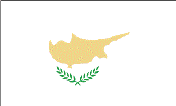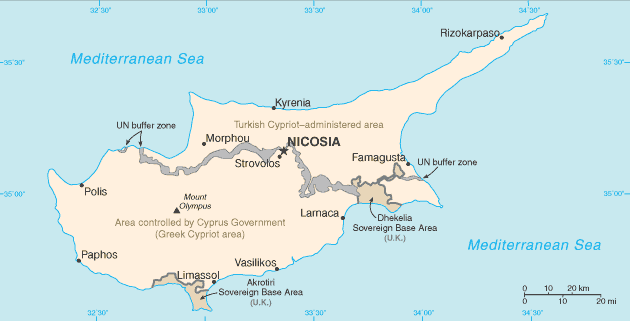|
Cyprus
|

|
Capital: Nicosia (Lefkosia)
Population: 1,179,551
Brief History of Cyprus:
Cyprus is an island country located in the Mediterranean Sea. The island was in an ideal location between many of the Eastern and Western empires. As a result, the island was part of many great ancient civilizations including Ancient Egypt, Persia, Ancient Greece, and the Roman Empire throughout its history. Starting in 364 AD, Cyprus was ruled for 800 years by the Byzantium Empire.
Beginning in the 12th century, the island changed hands several times until it came under control of the Ottoman Empire in the 1500s. In 1878 Great Britain took over the island and made it an official British colony in 1925. In
1960 Cyprus gained its independence from Great Britain. However different factions in the country could not get along. Starting in 1974, Cyprus has been divided into two sections. One side is controlled by the government and the other by Turkish Cypriots. Greek is spoken in the south and Turkish in the north. There is a buffer zone between the two sides where the United Nations keeps a peacekeeping force. Despite this odd situation, the island of Cyprus became a member of the European Union in 2004.
The Geography of Cyprus
Total Size: 9,250 square km
Size Comparison: about 0.6 times the size of Connecticut
Geographical Coordinates: 35 00 N, 33 00 E
World Region or Continent: Middle East
General Terrain: central plain with mountains to north and south; scattered but significant plains along southern coast
Geographical Low Point: Mediterranean Sea 0 m
Geographical High Point: Mount Olympus 1,951 m
Climate: temperate; Mediterranean with hot, dry summers and cool winters
Major cities: NICOSIA (capital) 240,000 (2009), Limassol
The People of Cyprus
Type of Government: republic
Languages Spoken: Greek, Turkish, English
Independence: 16 August 1960 (from UK); note - Turkish Cypriots proclaimed self-rule on 13 February 1975 and independence in 1983, but these proclamations are only recognized by Turkey
National Holiday: Independence Day, 1 October (1960); note - Turkish Cypriots celebrate 15 November (1983) as Independence Day
Nationality: Cypriot(s)
Religions: Greek Orthodox 78%, Muslim 18%, Maronite, Armenian Apostolic, and other 4%
National Symbol: Cypriot mouflon (wild sheep); white dove
National Anthem or Song: Ymnos eis tin Eleftherian (Hymn to Liberty)
Economy of Cyprus
Major Industries: tourism, food and beverage processing, cement and gypsum production, ship repair and refurbishment, textiles, light chemicals, metal products, wood, paper, stone, and clay products
Agricultural Products: citrus, vegetables, barley, grapes, olives, vegetables; poultry, pork, lamb; dairy, cheese
Natural Resources: copper, pyrites, asbestos, gypsum, timber, salt, marble, clay earth pigment
Major Exports: Republic of Cyprus: citrus, potatoes, pharmaceuticals, cement, clothing and cigarettes; north Cyprus: citrus, potatoes, textiles
Major Imports: Republic of Cyprus: consumer goods, petroleum and lubricants, intermediate goods, machinery, transport equipment; north Cyprus: vehicles, fuel, cigarettes, food, minerals, chemicals, machinery
Currency: Republic of Cyprus: Cypriot pound (CYP); Turkish Cypriot area: Turkish New lira (YTL)
National GDP: $23,720,000,000
** Source for population (2012 est.) and GDP (2011 est.) is CIA World Factbook.
Back to Geography Home Page
